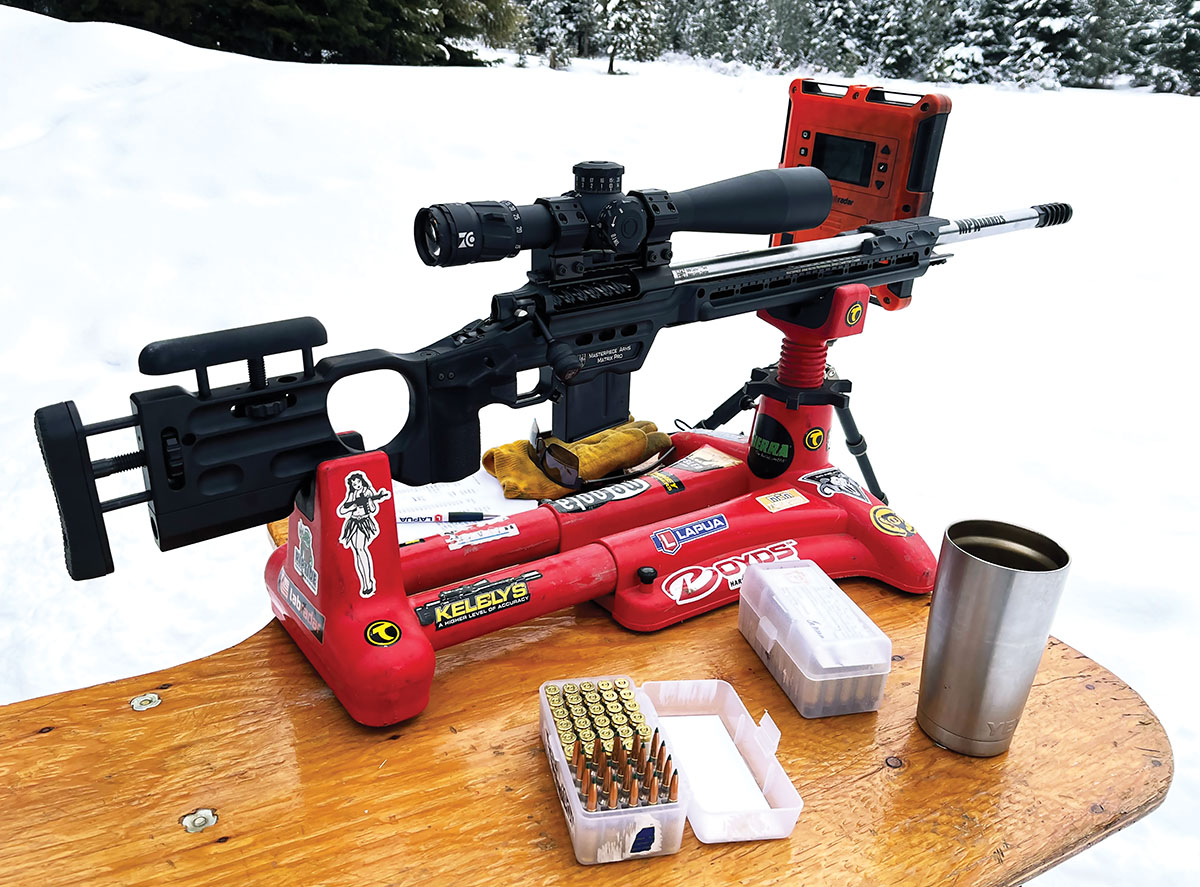
Shooting was conducted across a sturdy portable bench from atop an MTM Case-Gard K-Zone Shooting Rest. A LabRadar Doppler unit was used to establish velocities on this gloomy day.
The 6mm Dasher was designed to push high-ballistic coefficient/low-drag bullets to 2,900-3,000 feet per second (fps) while providing less drop and recoil than cartridges like the 6.5 Creedmoor. Since its inception, it has managed to capture a long list of 600- and 1,000-yard benchrest records – a list perhaps longer than any other single cartridge. In 2014, Jim Richards, shooting at the Deep Creek Range near Missoula, Montana, set a world record with his 6mm Dasher by placing 10 shots in a 2.6872-inch group at 1,000 yards while shooting in the Light Gun class. The Dasher has also become the new darling amongst many Precision Rifle Series (PRS) shooters.
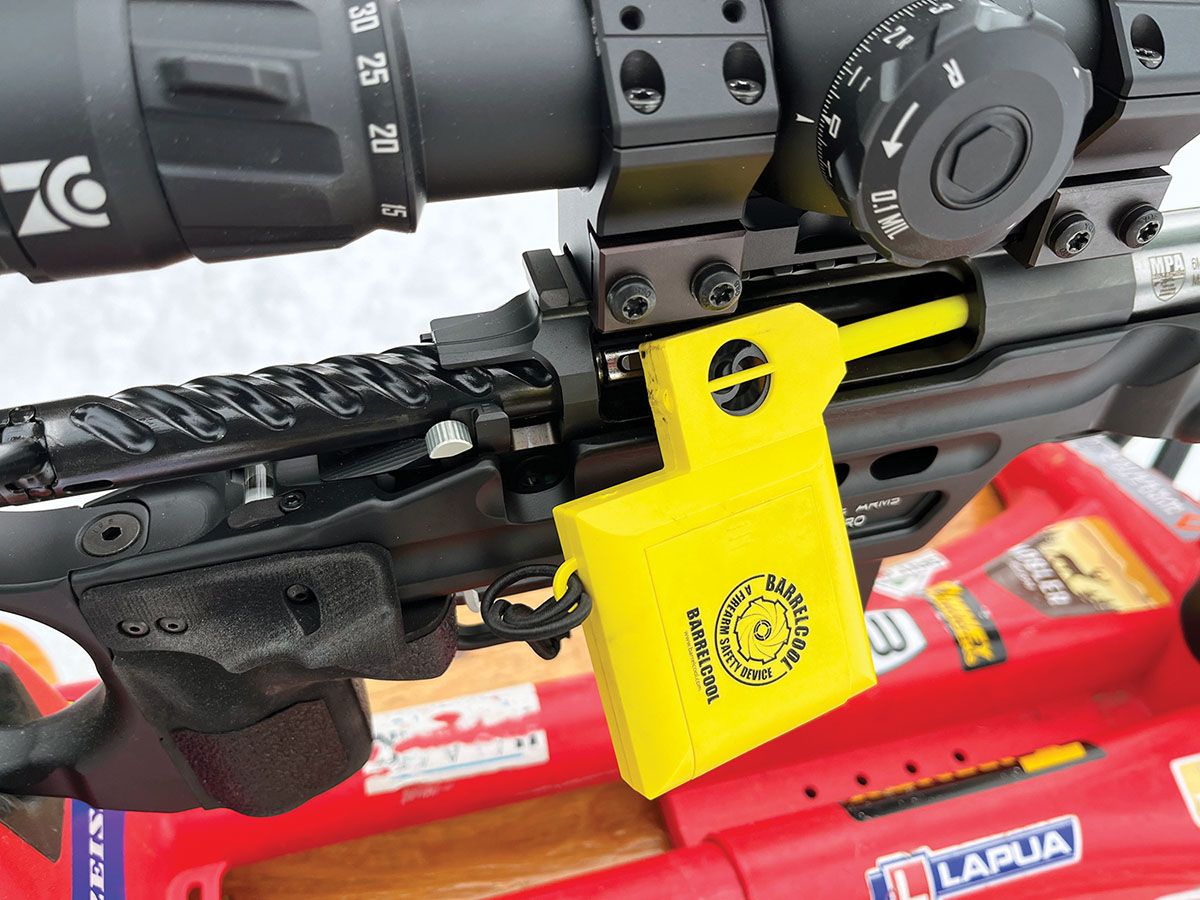
The heavy barrel of the MasterPiece Arms (MPA) Matrix Pro PMR rifle was slow to warm with the 6mm Dasher cartridge, allowing 15-shot strings without undue heating. Nonetheless, Patrick plugged in his Barrel Cool between target changes.
Well-known Gunsmith, Dan Dowling and friend, Al Ashton’s 6mm Dasher (Dan+Ash+er creating the name) was made in 1999, by fireforming 6mm BR brass to push the shoulder .100 inch forward (creating a 10 percent increase in powder capacity) and forming a 40-degree shoulder with a .260-inch neck. The result is 100 to 130 fps increase in velocity over the 6mm BR while shooting 105-grain bullets. This process forms a potent wildcat that holds about 41 grains of water, giving it the capacity to push 105- to 108-grain bullets to the 2,950-3,000 fps threshold many competitors find ideal for accuracy.
Dimensionally, the Dasher sits between the 6mm BR Norma at the lower end and 6mm Creedmoor at the higher. Barrel life is considered quite good for a 6mm cartridge, with competitive life normally spanning around 2,500-3,000 rounds. The 6mm Dasher is regarded as easy to load and capable of relinquishing excellent accuracy with a wide variety of powders, though Alliant Reloder 15 and Hodgdon Varget seem to be the current Dasher professional favorites.
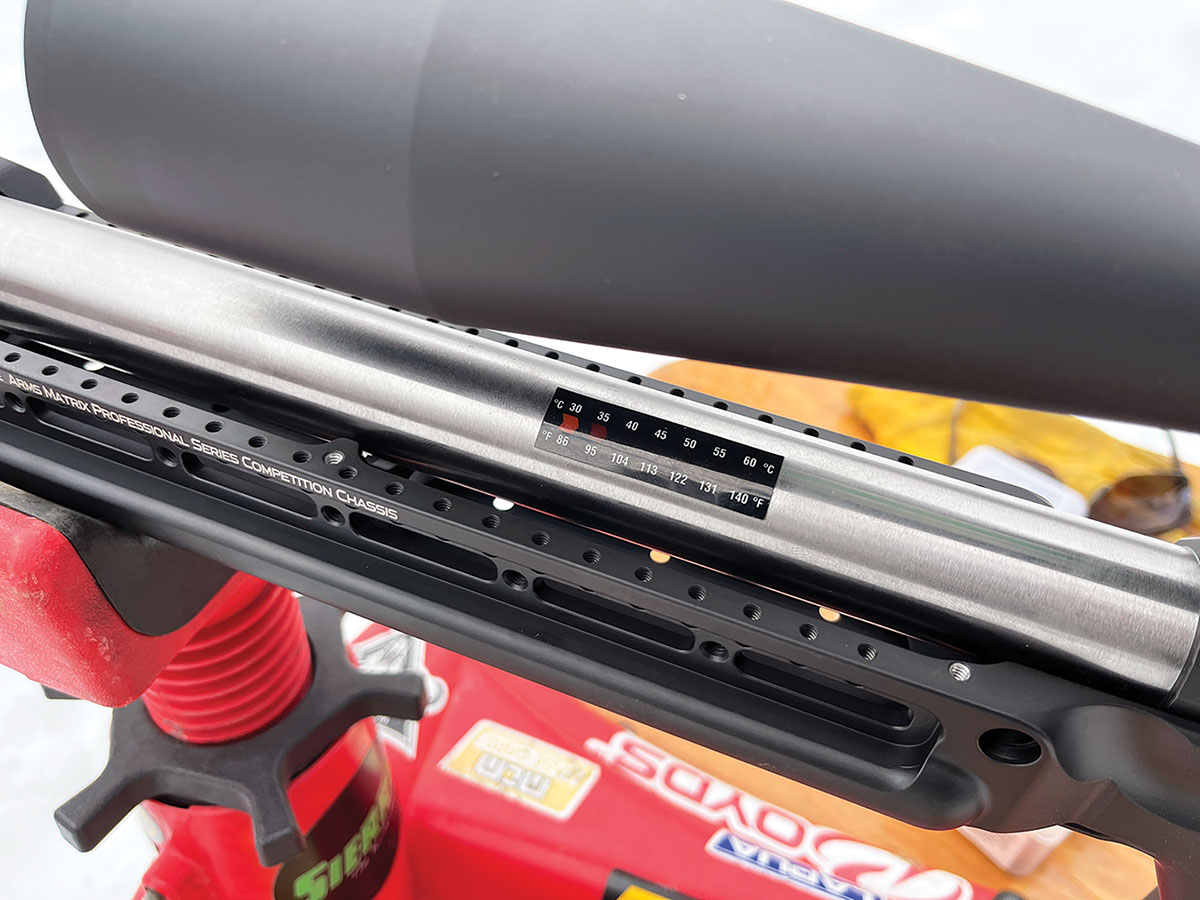
MasterPiece Arms’ rifles are typically equipped with a handy barrel temperature gauge. The barrel was extremely slow to warm, this image shows as hot as the barrel ever got during testing.
The Dasher is a fairly domesticated wildcat, given the availability of ready-made brass from Norma, Alpha Munitions and the Peterson Cartridge cases used here. This saves the tedious task of creating Dasher cases from 6mm BR Norma brass (necking 6mm BR cases up to 6.5mm before partially necking them back down to 6mm to help keep the case head firmly pressed against the bolt face during fireforming, followed by neck turning and trimming). Peterson Cartridge cases include small rifle primer pockets with .060-inch flash holes requiring a slim decapping pin. As no Sporting Arms and Ammunition Manufacturers’ Institute (SAMMI) standards are available, Peterson based dimension specifications are found in Sierra, Berger and Lyman handloading manuals – including .0013-inch neck-wall thickness that requires no turning, 1.53-inch overall loaded length, proper headstamps and harder case heads than most commercial brass.
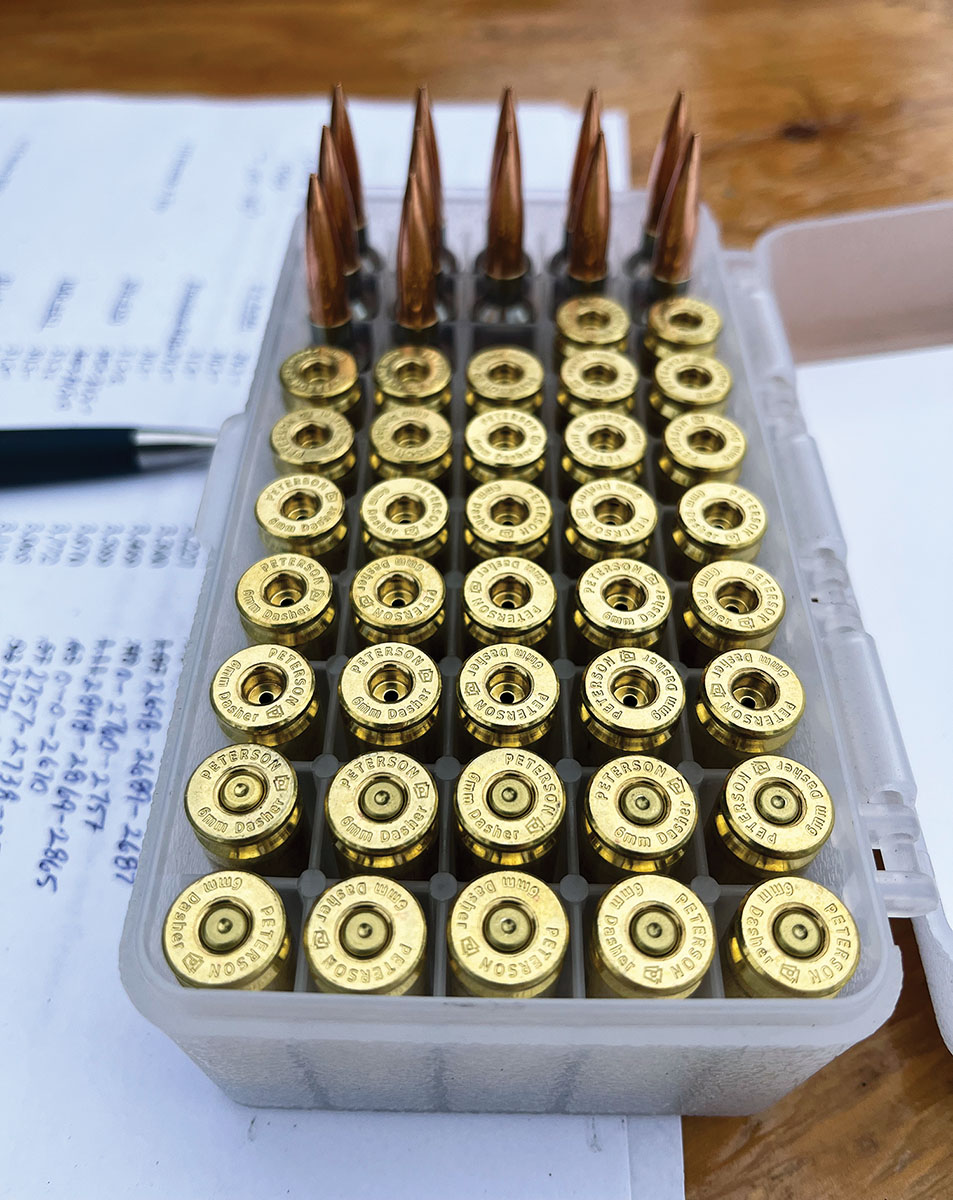
Patrick considers Peterson Cartridge brass among the best of the best. It certainly showed its worth during the 6mm Dasher test, with more than 50 percent of all groups shot printing into less than a half-inch.
A Redding Series D Deluxe Die Set was used to assemble loads. This set includes both full-length and neck-sizing dies, with the neck-sizing die used during this test in combination with the fresh Peterson Cartridge brass before chamfering mouths inside and out. The standard expander ball was replaced by a Redding 6mm Free Floating Carbide Button Kit to promote straighter necks during sizing and the standard seating stem was replaced by a Redding Micrometer head. I was able to get my hands on some Remington No. 7½ Small Rifle Bench Rest primers and I am happy to report they performed every bit as well as the pre-bankruptcy examples I’ve used previously.
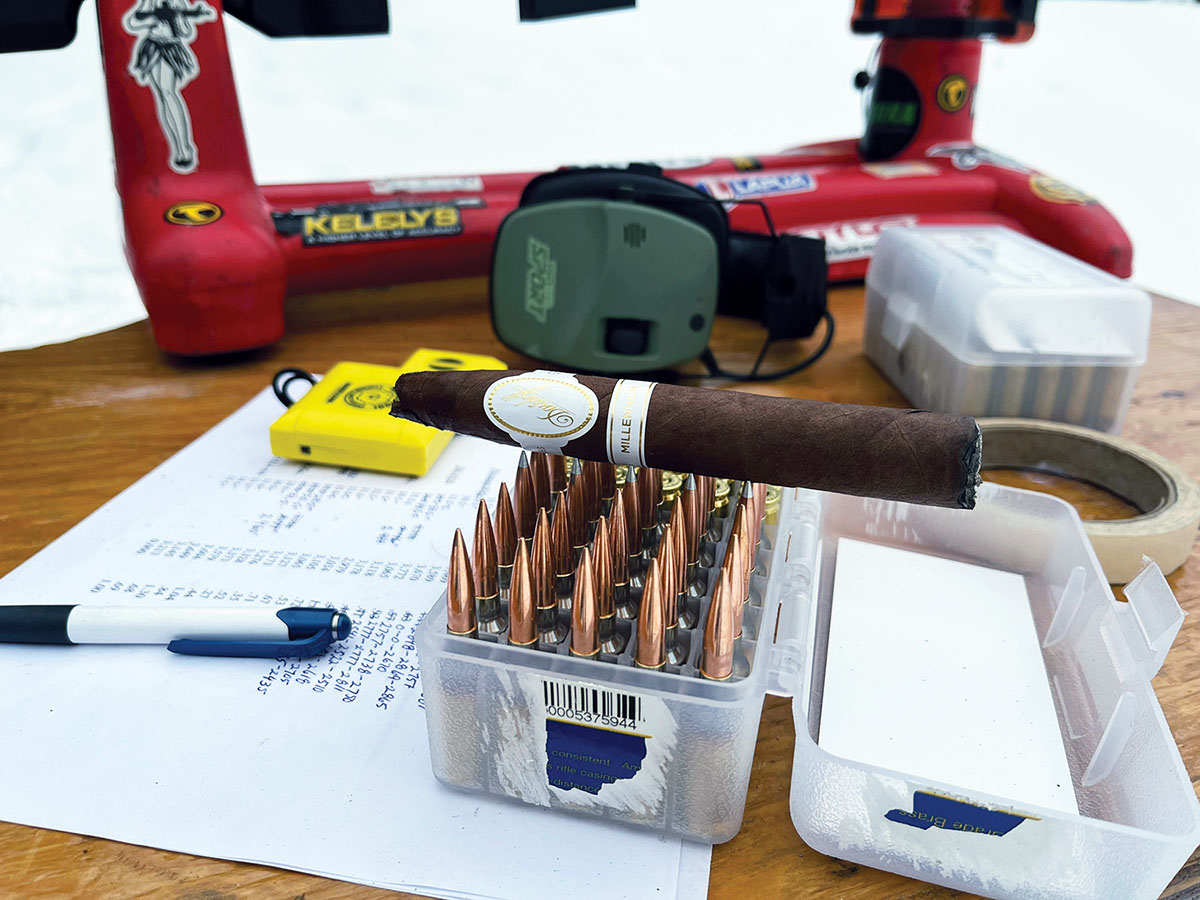
Patrick enjoyed a Davidoff Millennium Piramides cigar while conducting his 6mm Dasher test.
The test rifle was created by MasterPiece Arms (MPA), a company I became acquainted with while working with the 6mm ARC immediately following its release. MPA turns out some fantastically accurate chassis rifles. The MPA Matrix Pro PMR Rifle meets the Production Class requirements for the 2023 PRS, and includes MPA’s newest Matrix Pro II chassis in black or tungsten and a barreled action borrowed from the company’s PMR Series rifles. The MPA/Spencer barrel is a polished 26-inch Match Contour and made from 416RQ stainless steel, stress relieved and hand-lapped before being video borescoped and Sheffield air gauge inspected to within .0001 inch. The chamber is also indicated within .0001 inch or less to the rifle bore. In the 6mm Dasher, the precision gun drilled, reamed, honed pull button rifling included a 1:7 twist and the chamber was reamed specifically for Peterson’s Cartridge brass. An MPA DNS muzzle brake was included on the 5⁄8x24 threads. The American Rifle Company’s action is made with wire EDM machines making the bolt-lug and raceway provide silky-smooth cycling of the three-lug system. The recoil lug and 20-MOA Picatinny rail are integral to the action. The three-piece bolt includes spiral fluting, a mechanical extractor, and a quick-release firing pin assembly removal system for fast, toolless cleaning – all black nitride coated for long life.
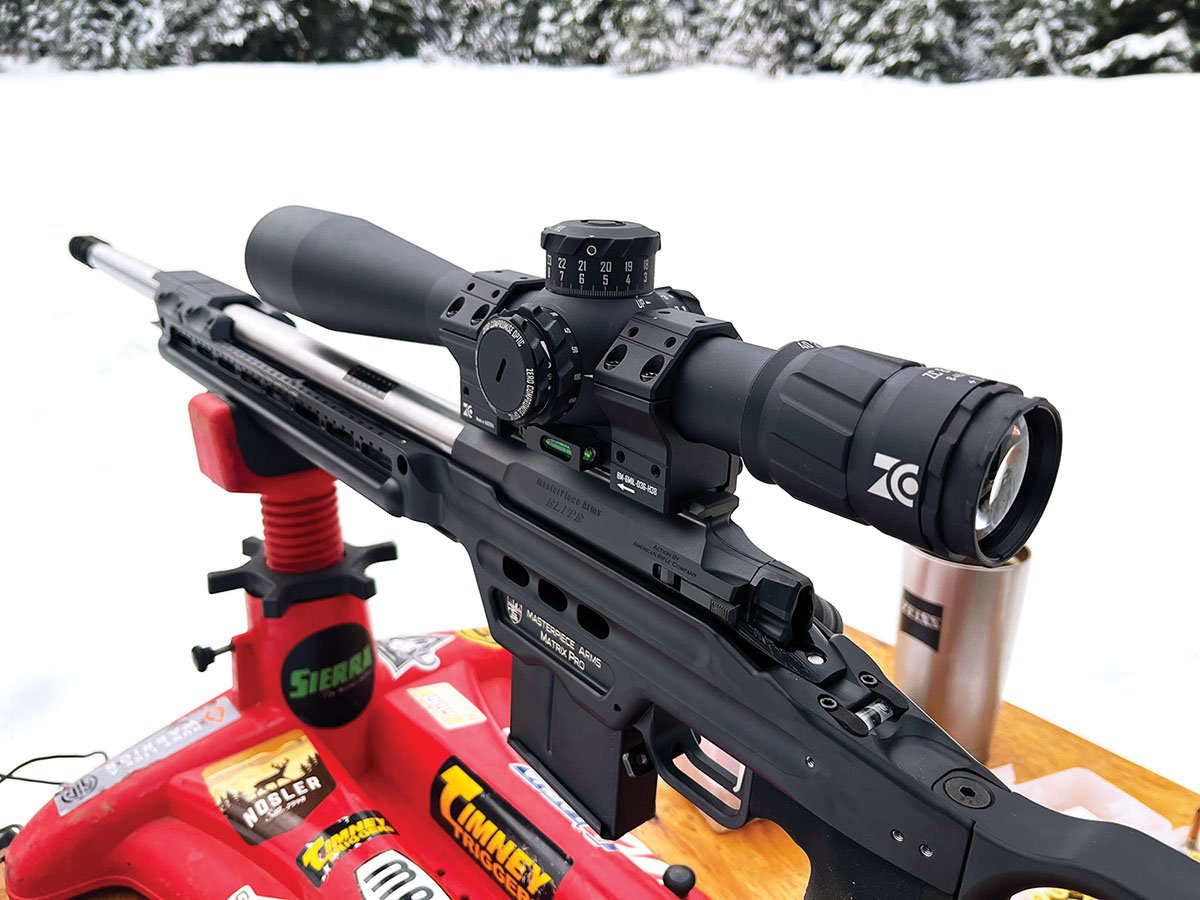
The test rifle held a Zero Compromise Optic ZC840 8-40x 56mm scope mounted in the same company’s Block Mount 6-Mil D36-H38 base with built-in level. The optic uses Austrian-made glass and components are assembled in northern Idaho.
The chassis includes 6061 aluminum construction. The V-bedding system provided additional clearance for glass bedding the action and straight section of the barrel. The cheek riser and length of pull are wheel adjustable (12.75 to 14 inches), and it features a bag rider with butthook. A night vision bridge, steel spigot mount (Picatinny rail and Arca Swiss Rail), built-in inclinometer, Matrix EVG grip and thumb ledge are also provided. It is also RAT system compatible. The trigger was an MPA Bix N Andy Tac Sport Pro Custom and broke at 1-pound, .2 ounces, and the rifle fed reliably from an Accurate Mag AICS 10-round detachable magazine with all loads. The rifle comes with a 3⁄8-inch accuracy guarantee and a basic Plano case. As delivered, the bare rifle weighed 16 pounds.
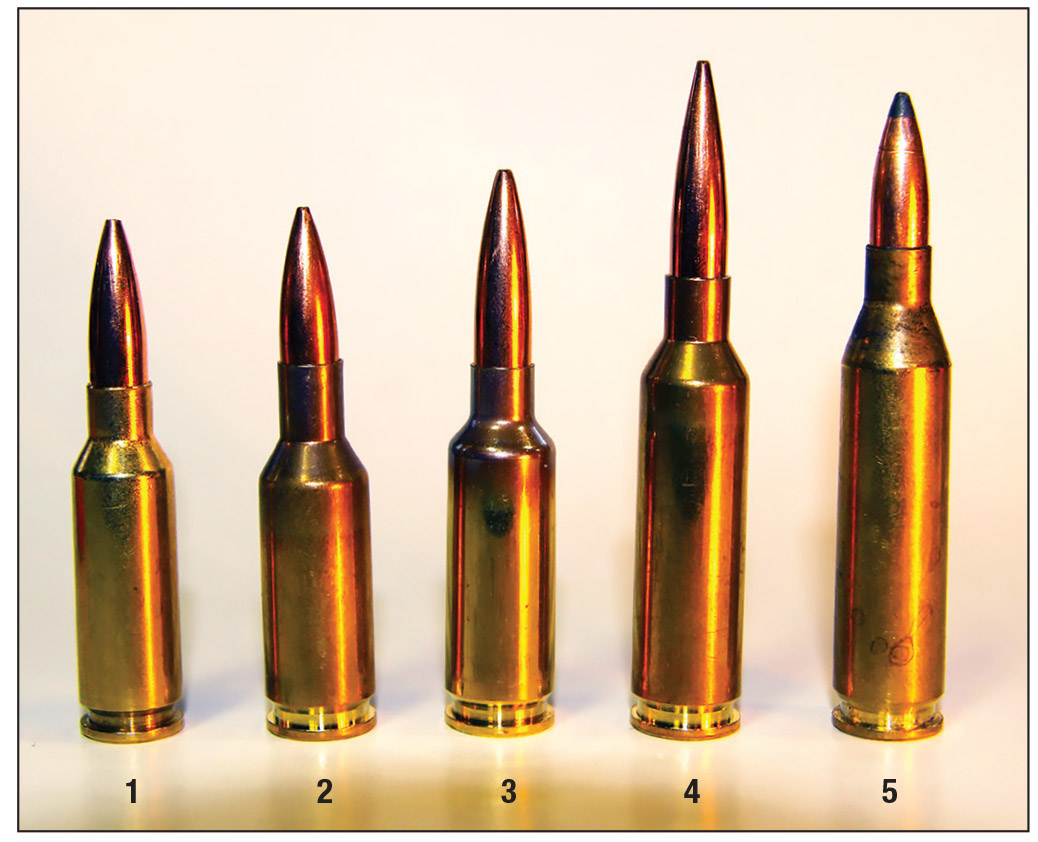
Shown for size comparison: (1) 6mm ARC, (2) 6mm BR Norma, (3) 6mm Dasher under discussion, (4) 6mm Creedmoor and (5) 243 Winchester.
A true long-range cartridge and rifle deserves a true long-range optic and the Zero Compromise Optic ZC840 8-40x 56mm is certainly that. This is a precision long-range scope with pop-up locking turrets (mil in this case) and an illuminated MPCT 2x reticle. I can honestly say this is the finest riflescope I’ve ever had the pleasure of shooting; the Austrian glass is like looking through air even at the highest 40-power magnification. It was mounted in an Austrian-made Zero Compromise Block Mount 6-Mil D36-H38 one-piece base, which included a swing-out rifle level. This optic is deserving of a much longer discussion than room permits here, so I reviewed it in my “A Rifleman’s Optics” column in
Rifle No. 335 (July – August 2024). With scope installed, the finished rifle weight was 20.86 pounds.
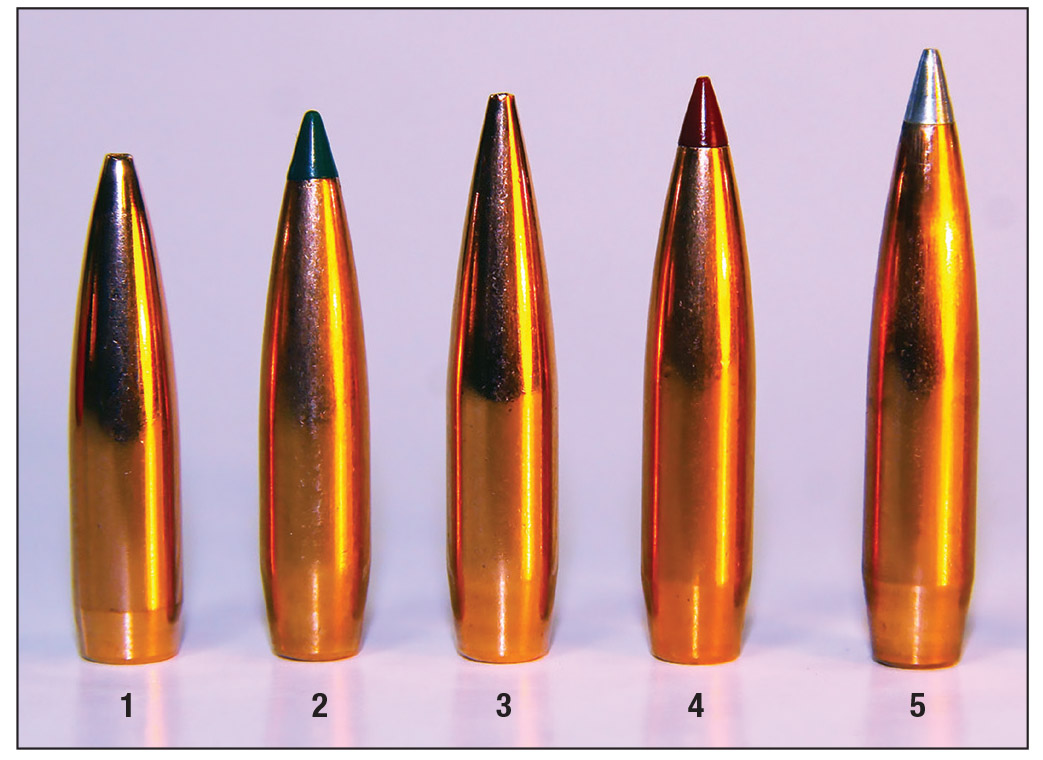
Bullets used to run the 6mm Dasher through the paces included: (1) Lapua’s 90-grain Scenar-L, (2) Sierra’s 95-grain Tipped MatchKing, (3) Berger’s 105-grain VLD Target, (4) Hornady’s 108-grain ELD Match and (5) 110-grain A-Tip Match.
Target bullets from 90 to 110 grains were selected from Lapua, Sierra, Hornady and Berger – all relinquishing best-in-class ballistic coefficients (BC) for weight. Shooting was conducted on a blustery winter day with temperatures in the mid-20s Fahrenheit – not exactly ideal for assembling tiny benchrest groups. Despite frozen toes and fingers, the MPA rifle produced some of the smallest groups I have ever shot. This was a rifle/cartridge combination so accurate I found myself groaning after assembling groups measuring “only” a half-inch.
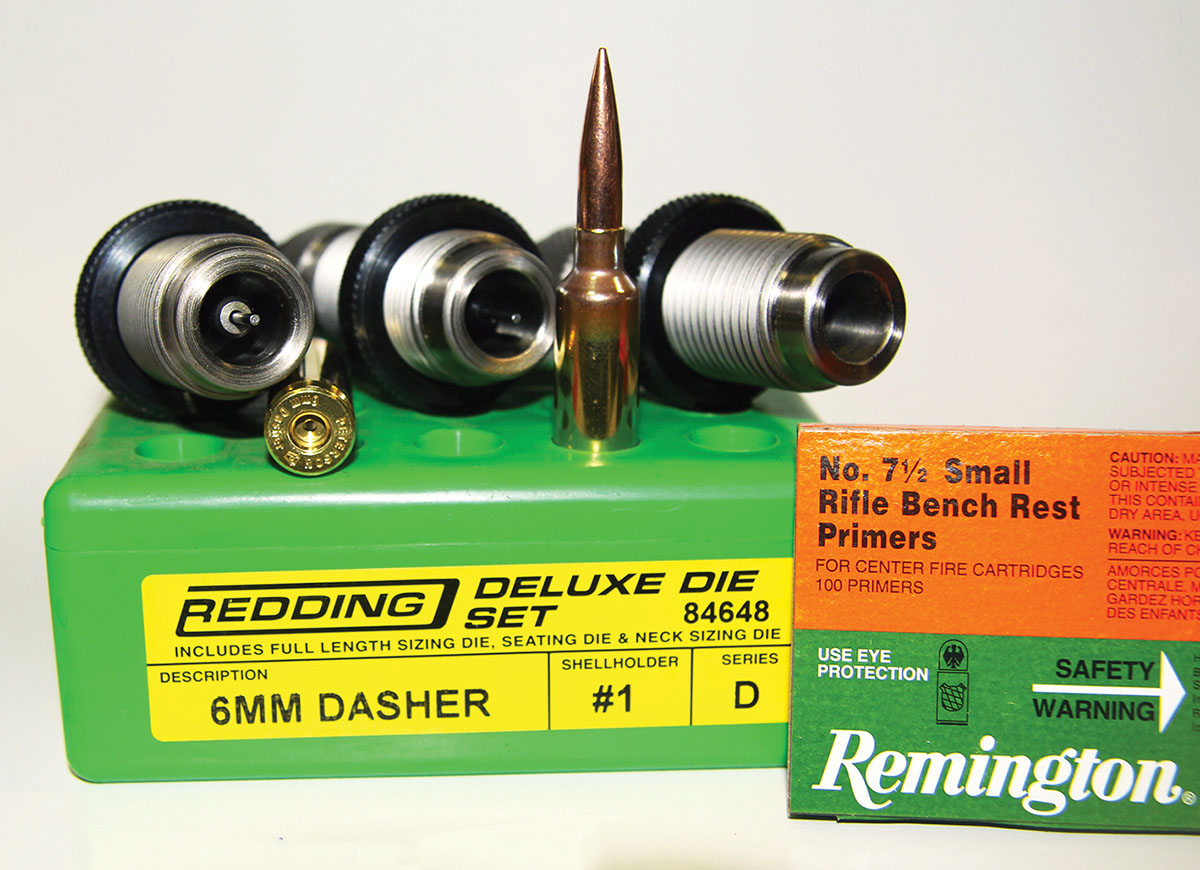
A Redding Series D Deluxe Die Set with added 6mm Free Floating Carbide Button Kit and Redding Micrometer head, Remington No. 7½ Small Rifle Bench Rest primers and Peterson Cartridge brass were used to assemble all loads.
Lapua’s Scenar-L is Finland’s answer to Sierra’s BTHP MatchKing, with the 90-grain version selected here. It included a .434 G1 BC and was paired with Vihtavuori’s N140, Alliant Reloder 16 and Hodgdon H-4350. This bullet absolutely smashed it, including two groups in the “point-ones.” Every powder produced groups under ¼-inch. H-4350 did it with a maximum/compressed load of 34.5 grains at 2,901 fps, Reloder 16 with a maximum/compressed load of 35 grains at 2,972 fps, and N140 with 30 grains at 2,723 fps. The Reloder group measured .16 inch and the N140 load .12 inch – the latter likely the smallest group I have ever shot.
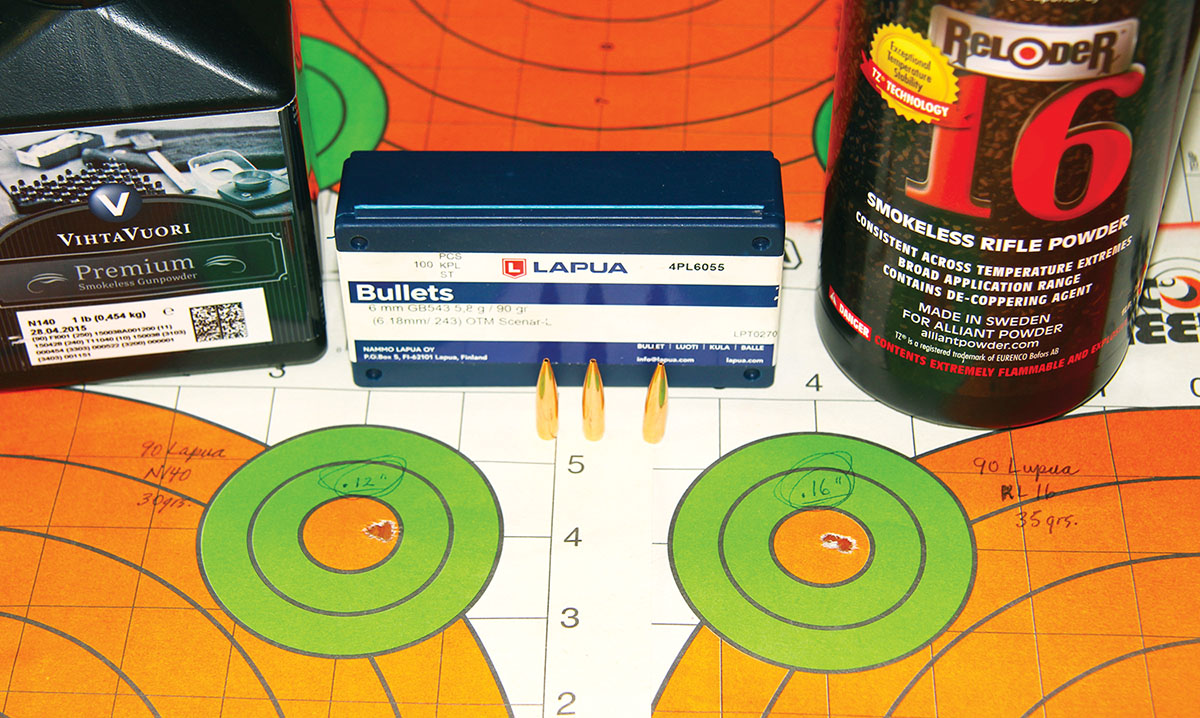
The best two groups assembled with Lapua’s 90-grain Scenar-L included a .12-inch group at 2,723 fps using 30 grains of Vihtavuori N140, and .16-inch group at 2,972 fps using 35 grains of Alliant Reloder 16.
Sierra’s 95-grain Tipped MatchKing includes a streamlined poly-tip/boat-tail profile, which creates a phenomenal long-range .500 G1 BC combined with a weight that generates some serious velocity. Vihtavuori N140 was tried again on the promise of top accuracy, Hodgdon CFE 223 on the promise of top velocity and Alliant Reloder 15 because of its status as a competition favorite. N140 started off well with a sub-¼-inch group at 2,811 fps using 30.5 grains of powder, but fell off quickly with added velocity. Reloder 15 nearly broke a ¼-inch, with a maximum/compressed load of 33 grains at 2,992 fps. CFE 223 provided both top velocities and the tightest group – .17 inch at 2,940 fps using 33.5 grains of powder, and .23 inch at a smoking 3,133 fps using a maximum load of 35.5 grains. My gut feeling was that a .001- to .002-inch deeper seating depth would’ve introduced a bit more consistency with this bullet.
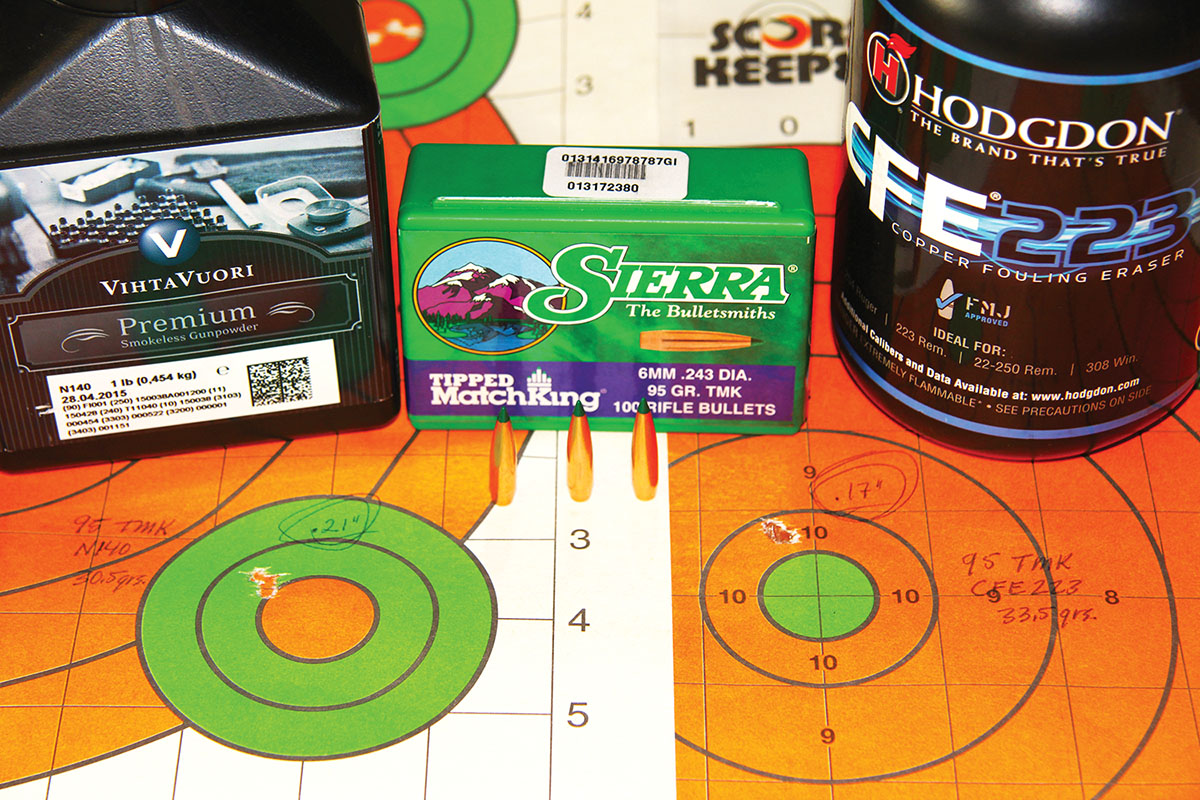
Sierra’s 95-grain Tipped MatchKing’s two best groups included .21 inch at 2,811 fps using 30.5 grains of Vihtavuori N140, and .17-inch at 2,940 fps using 33.5 grains of Hodgdon CFE 223.
Berger’s 105-grain VLD Target is no doubt responsible for some of the world records established with the 6mm Dasher. The spear-like tip and sleek boat-tail created a .517 G1 BC. I chose Hodgdon Varget, Accurate 4064 and Shooters World Precision Rifle to propel this bullet. Precision Rifle failed to supply any “point-two” -inch groups, its best showing was .38 inch at 2,638 fps using 29 grains of powder. Varget assembled two groups hovering around ¼-inch with 31 and 32 grains (maximum) of powder at 2,793 fps (with single-digit extreme velocity spread) and 2,878 fps. The surprise accuracy winner was A-4064, producing a .19-inch group at 2,606 fps using 29.5 grains of powder, in addition to two other fine groups.
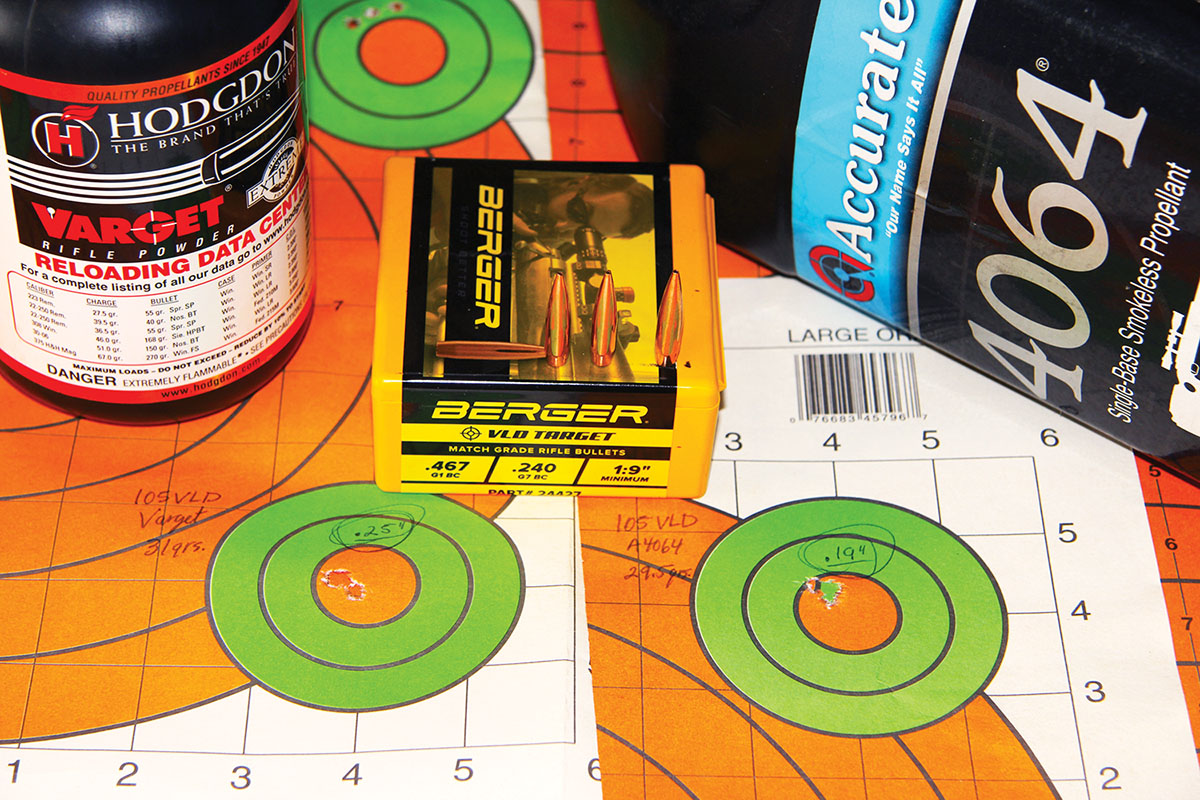
Berger’s 105-grain VLD Target produced two fine groups, including .25 inch at 2,793 fps with 31 grains of Hodgdon Varget, and .19 inch at 2,693 fps with 29.5 grains of Accurate 4064.
The 108-grain ELD Match from Hornady has a proprietary Heat Shield Tip to eliminate long-range heat distortion and an AMP Jacket for excellent uniformity bullet to bullet. The polymer tip and elongated boat-tail gave this bullet a .536 G1 BC. Many serious long-range shooters I know use these bullets on big game, telling me they expand more reliably at distance than the tougher ELD-X. Winchester StaBALL 6.5, Vihtavuori N540 and Shooters World Precision Rifle fueled this experiment. Given more time, I would shoot this bullet again, as I could feel the slightest bit of resistance while turning down the bolt of this silky-smooth rifle, and these loads needed at least .002 inch of additional seating depth. As is, StaBALL 6.5 produced a .30-inch group at 2,834 fps using a maximum/compressed load of 36.5 grains, and N-540 a .40-inch group at 2,691 fps using 29.5 grains of powder. Precision Rifle proved most consistent, with groups measuring between .42 and .45 inch at velocities between 2,670 and 2,788 fps, the smallest group also including a single-digit extreme velocity spread.
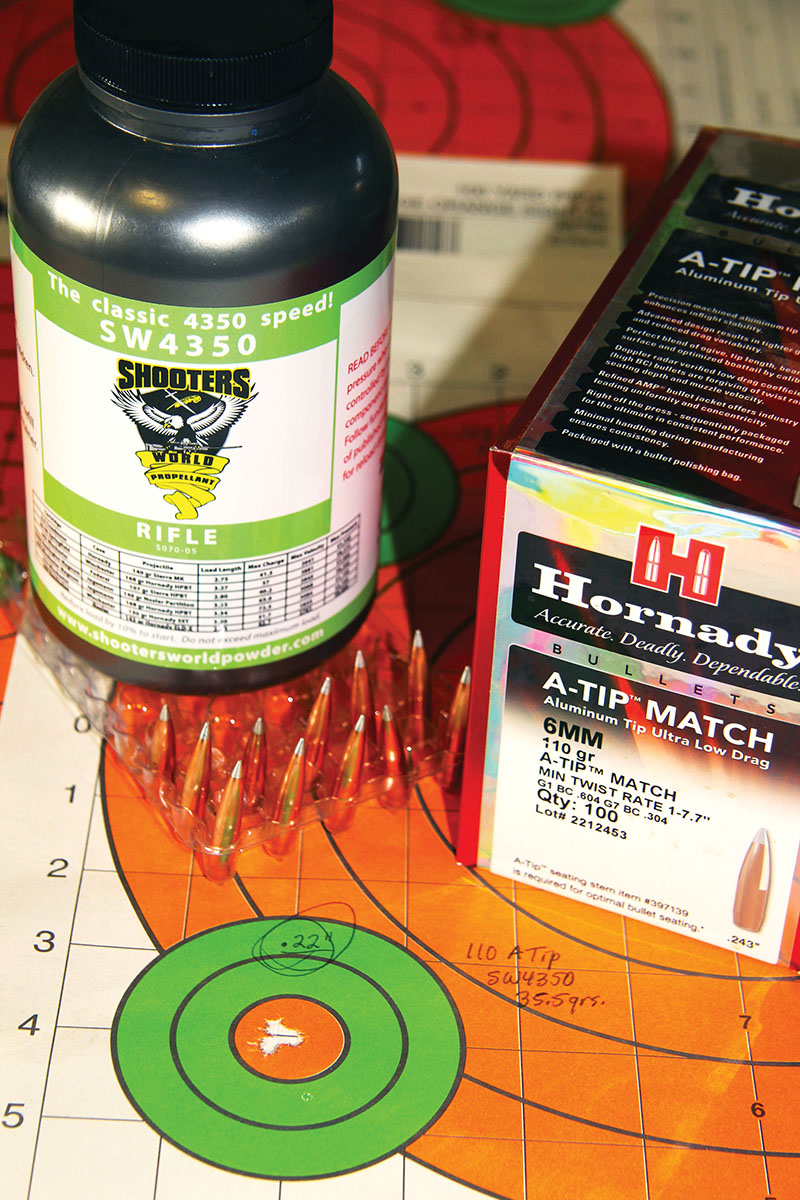
Shooters World SW 4350 proved the right combination with Hornady’s 110-grain A-Tip Match, putting three shots into .22 inch at 2,690 fps at 100 yards with a charge of 35.5 grains of powder.
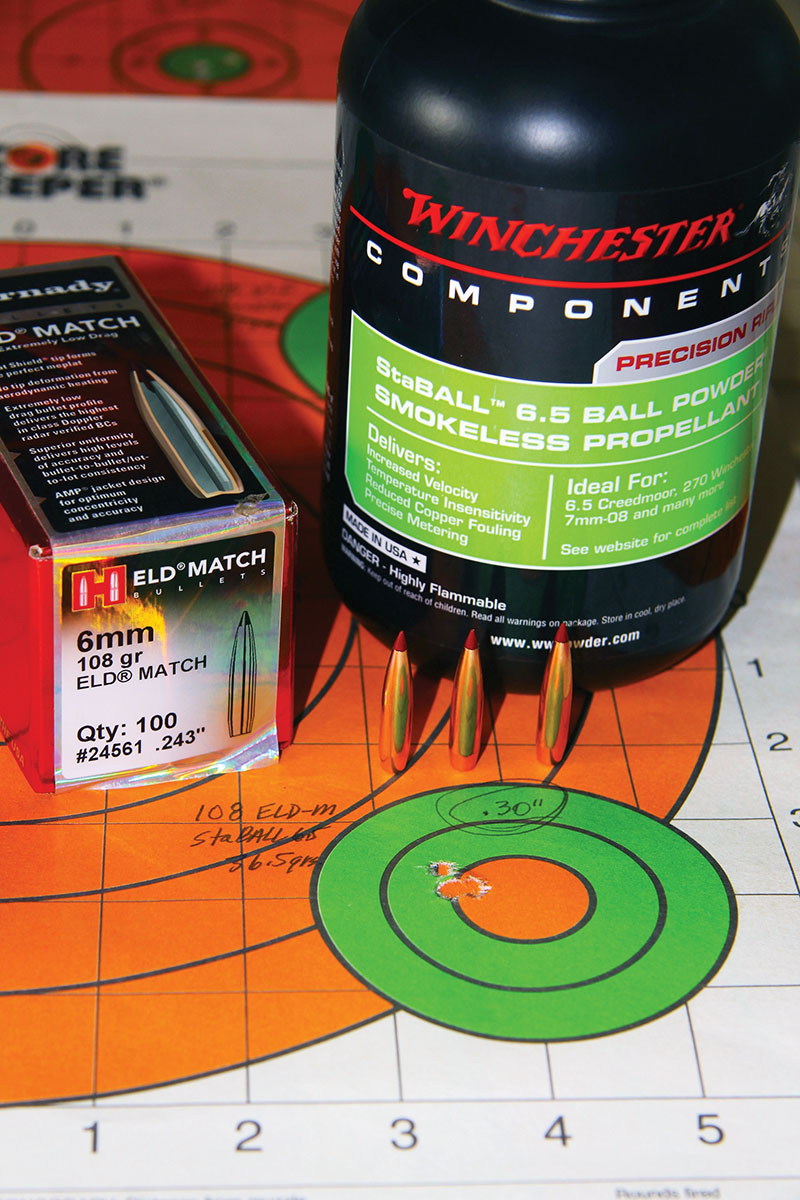
Hornady’s 108-grain ELD Match struggled a bit due to a seating depth slightly on the long side, but managed a .30-inch group at 2,834 fps using 36.5 grains of Winchester StaBALL 6.5.
The second Hornady bullet of the test was the 110-grain A-Tip Match, which holds a precision-machined aluminum tip and advanced engineering to maximize BC and accuracy. The phenomenal .604 G1 BC was verified by Doppler radar and this bullet required a 1:7.7 minimal twist rate for reliable stabilization. This bullet was matched with Shooters World’s versatile SW-4350 and IMR-4451 Enduron, with Alliant Reloder 16 added while seeking higher velocities. IMR-4451 produced three groups slightly above or well below ½-MOA and velocities just slightly below the other powders. Reloder 16 started out well with a .28-inch group at a pokey 2,584 fps with 31 grains of powder, with groups opening only slightly as more powder was added. It proved the fastest of the three powders paired with this bullet. Shooters World 4350 started with a .33-inch group at 2,524 and finished with a .22-inch group at 2,690 fps using a compressed/maximum load of 35.5 grains of powder, making it an easy winner.
While some jaw-dropping groups certainly resulted, others served to provide solid starting points and could no doubt be tweaked through some jockeying of charge weights and especially seating depths. I’m aching to spend more time behind this rifle. Accurate rifles make me happy, and this rifle and cartridge are perhaps the most accurate combination I’ve shot to date.
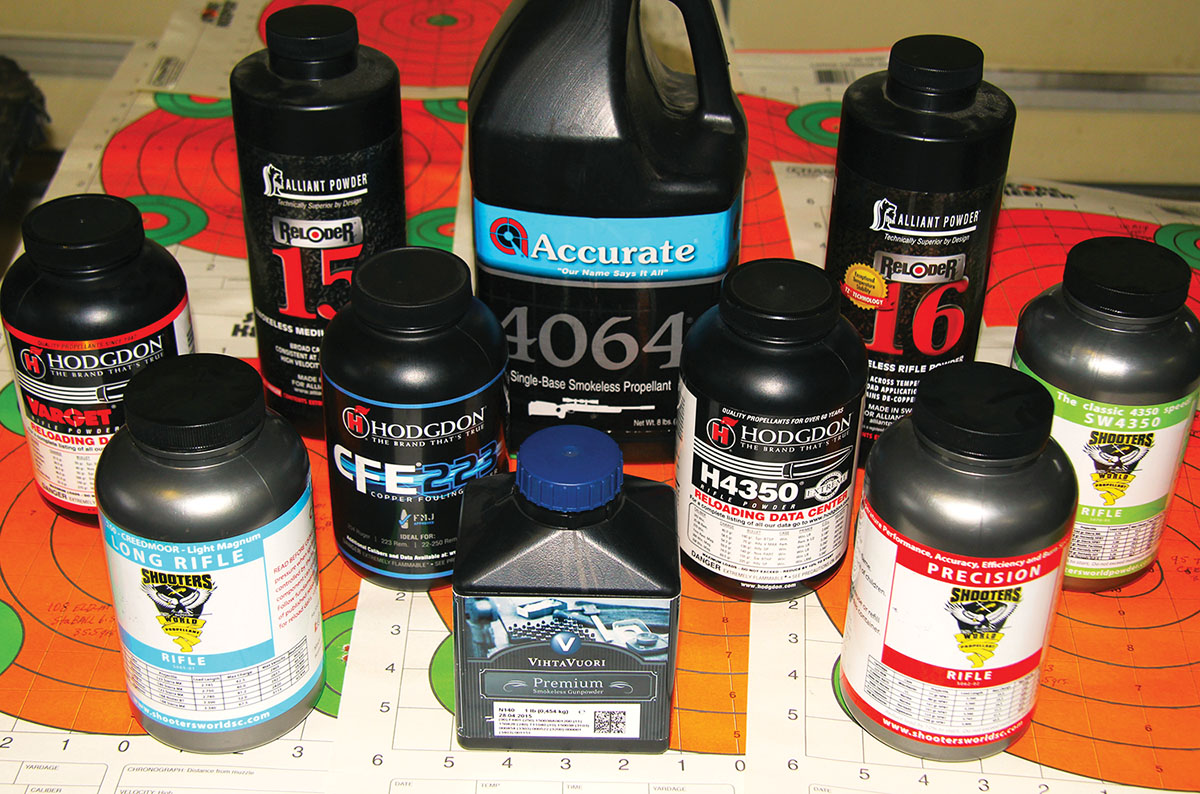
Patrick considers these the best powder choices for the 6mm Dasher (back row, left to right): Hodgdon Varget, Alliant Reloder 15, Accurate 4064, Alliant Reloder 16 and Shooters World 4350; (front row, left to right): Shooters World Long Rifle, CFE 223, Vihtavuori N140, H-4350 and Shooters World Precision Rifle.















.jpg)


